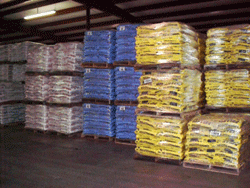Well Water Filtration Mistakes

Well water filtration mistakes can be hard to avoid. We try to make these mistakes easy to avoid. It is always a good idea to speak with one of our friendly specialists before you buy anything from anyone. They will never ask you to buy anything. And they will never pressure you in any way. They just answer your questions honestly. And provide you with in formation you need to make sound and logical decisions. Even if you buy somewhere else.
CALL TOLL FREE: 800-684-0979
E-mail: support@waterfiltersofamerica.com
What are the three biggest mistakes people make when buying a water softener or water filter?
- Using a water softener as an iron filter
- Drinking the water from ANY water softener
- Not understanding pH and flow rates in regards to well water filtration
Today we will discuss item #1, water softeners and iron water filtration:
Using a Water Softener as an Iron Filter:
You should virtually NEVER use a water softener as an iron filter, and you should be wary of anyone who suggests you do such a silly thing. Iron causes damage to a water softener’s mineral bed and makes water softeners use a lot more salt. Eventually running measurable amounts of iron to a water softener will certainly result in expensive service calls, and at some point is destined to cause the mineral to need to be replaced. This is a scientific fact. Using a water softener to remove iron in well water is something that companies with marginal tactics and practices hope for, as it increases their ongoing or “residual” income.
In-home sales companies frequently use this shady tactic to generate ongoing income from unsuspecting consumers. And now these shady operators are starting online companies and doing the same thing. They try to keep people confused with a lot of conflicting information to help them sell their marginal products. And treating well water is a SIMPLE, easy and inexpensive thing to do. If you are confused, then that is your first sign you should step away from that company and move on. We keep things simple here and everything makes common sense that almost anyone should be able to understand. It is simple to understand that if you have a measurable amount of iron (.3 or higher), you SHOULD use an iron filter to remove that iron.
If the water is very hard you can add a water softener AFTER you remove the iron from the water, which will then be highly efficient as it only has to do one job which is remove hardness. That is what a water softener is for. That is the ONLY job a water softener was meant to do. Using this method our average customer says they add salt about once per year when the water softener is properly applied. People who use water softeners as iron filters may find that absolutely amazing to hear, as they are usually using MASSIVE amounts of salt. And usually the person who told them to do such a foolish thing is selling them the salt as well!
And if you ever have a salesman tell you to use “Iron Out” or some other iron removal chemicals to treat the softener, you know you have the wrong person advising you to begin with. Many of those chemical makers themselves will tell you NOT to use iron removal chemicals to clean water softeners and the minerals inside. Some actually say it right on the box or container the iron removal chemical comes in. And if the person is also telling you that it is OK to drink that water, then you can be certain you need to run for the hills. The way you know that person is misrepresenting the facts is that his lips are moving…
Water softeners use “ionic exchange” to remove hardness. A proper iron filter uses “water filtration” to remove iron. These are two entirely different things. You want a water softener to regenerate or backwash as little as possible. The normal frequency for it to clean or regenerate or backwash itself is 7 to 10 days. That way you are not using massive amounts of unnecessary water and salt. If you let iron sit in the water softener tank for ten days it attaches itself to the minerals and eventually the water softener minerals become “Iron Bound”. Once they become iron bound they can no longer function properly or efficiently, and they can no longer remove the iron from the mineral bed effectively.
Now the mineral starts using massive amounts of salt and will eventually need to be replaced. This is the beginning of how the unscrupulous water dealer lines his pockets with your hard earned cash. A water filtration device intended to remove iron must backwash or clean itself on a very regular basis to avoid becoming iron bound. It is just that simple. A water softener regenerates infrequently, and an iron filter backwashes very frequently. Can you see how simple it is to determine that you can not use one method to properly correct both problems? This is a very common well water filtration mistake.
The best type of iron filtration is to use an “oxidizing” filter for iron removal such as the Terminox® filter. Our Terminox® iron filters remove iron, sulfur, manganese, dirt, turbidity, smells, tastes and even harsh chemicals such as chlorine. They use no salt or chemicals and are virtually maintenance free. Just set it and forget it. You can find them on this page: Iron Filters
| NOTE: Be wary of people who mistakenly tell you to use iron filters that use harmful or toxic chemicals, such as greensand filters, and tell you they work like an oxidizing filter such as Terminox™. That is absolutely misleading and shamefully untrue. Also be wary of claims of salesmen selling marginal filters like Filox ® that mix different minerals in the same tank. Minerals such as “Birm”. Birm destabilizes the oxidizing mineral with another mineral that does not oxidize. And oxidizing minerals need an “Undisturbed” mineral bed depth to work properly. Birm filters also require a pH of 8.0 to remove multiple contaminants such as iron AND manganese. Birm does NOT remove sulfur or chlorine either as a superior filter does, such as Terminox™. So if you ever develop iron bacteria and have to chlorinate the water, you would need another filter after the Birm filter. Terminox removes chlorine too. We should know. We sell all of these different types of water filtration systems. We know how all of them work. There is no question that Terminox™ is far superior to any iron filter we sell. |
The majority of people we see who have been sold a water softener as an iron filter. Never needed a softener to begin with. Or the unnecessary maintenance and expense of adding massive amounts of salt and ongoing service issues. A lot of iron in the water often makes it act like the water is really hard when that is not always the case. With a superior iron filtration system such as Terminox®, the water will be great to drink without adding reverse osmosis like you would have to do with a water softener.
Don’t drink softened water
Remember you should not drink the water from ANY water softener as a rule. This is one of the most common well water filtration mistakes. You should either drink bottled water, or add reverse osmosis ($199) to the kitchen sink for all of your cooking and drinking water. You can also connect up to two additional water using appliances, including refrigerators, freezers and ice makers to a single reverse osmosis unit when properly applied.
-Water Filtration Wizard


Leave a Reply